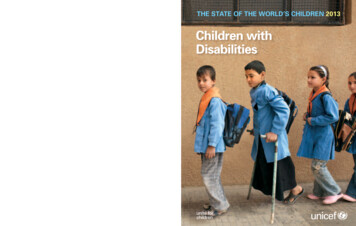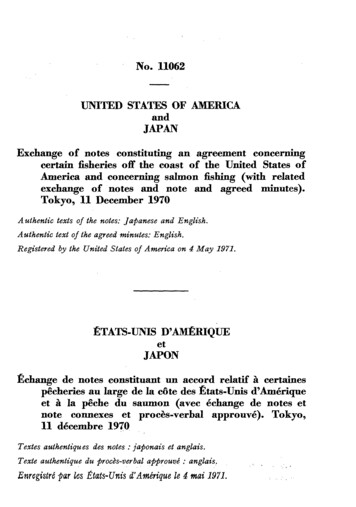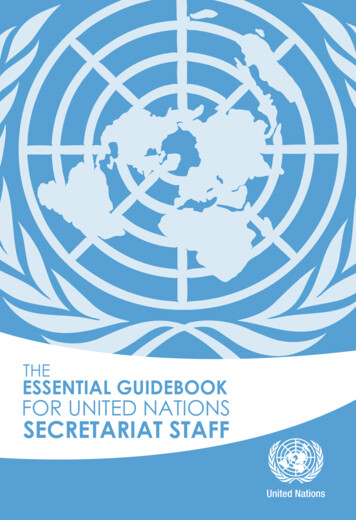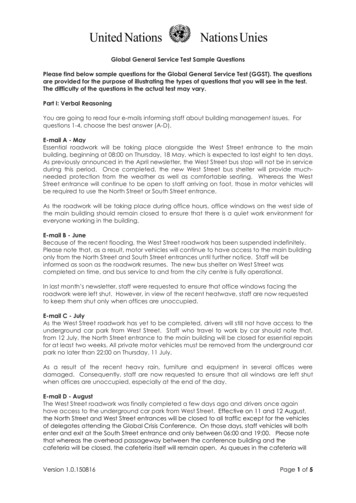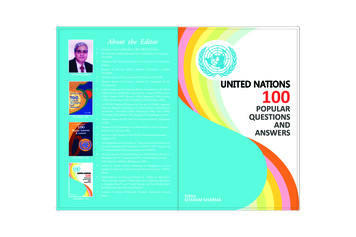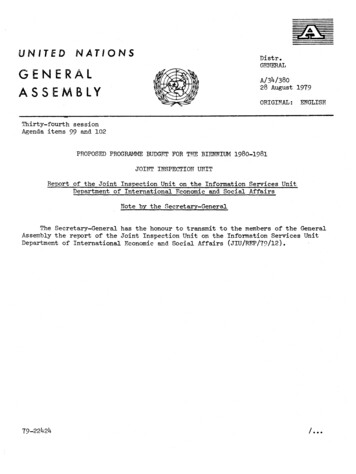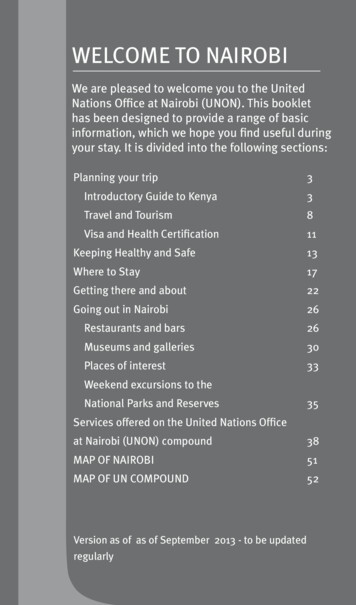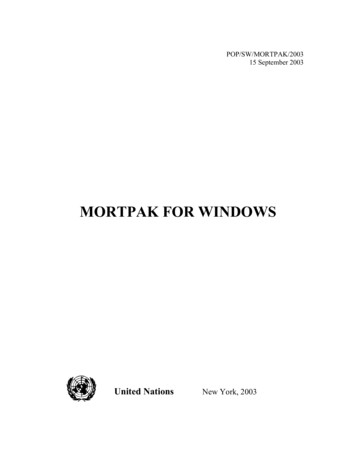
Transcription
POP/SW/MORTPAK/200315 September 2003MORTPAK FOR WINDOWSUnited NationsNew York, 2003
PrefaceThe present volume contains the working manual for MORTPAK for Windows,the United Nations software package for demographic measurement in developingcountries. The MORTPAK software packages for demographic measurement have hadwidespread use throughout research institutions in developing and developed countriessince their introduction in 1988. MORTPAK includes 17 applications in the areas ofpopulation projection, life-table and stable-population construction, graduation ofmortality data, indirect mortality estimation, indirect fertility estimation, and otherindirect procedures for evaluating age distributions and the completeness of censuses.The package incorporates techniques that take advantage of the United Nations modellife tables and generalized stable-population equations. MORTPAK for Windows is thefirst version with a Windows user interface. The package, as presented here, has beenconstructed with worksheet-style, full screen data entry which takes advantage of theinteractive microcomputer environment and reduces dependence on a manual.The Population Division of the Department of Economic and Social Affairs of theUnited Nations Secretariat has long conducted demographic estimation and projectionactivities at the country level, incorporating methodological advances in the constructionof model life tables, for example. As a by-product of these activities, this extensive bodyof computer software has been developed. MORTPAK has already been well tested andis now widely used for analysis of developing country data and in developing countryinstitutions. The design of the applications in MORTPAK as well as the programMATCH has its origins in the United States Census Bureau package, Computer Programsfor Demographic Analysis (Arriaga, Anderson and Heligman, 1976).The Population Division would be pleased to receive comments on experiencesusing MORTPAK that would enhance the international usefulness of future softwaredevelopment activities. Please contact: the Director, Population Division, Department ofEconomic and Social Affairs, United Nations, New York, New York 10017, USA.iii
CONTENTSPagePreface .INTRODUCTIONA. The Demographic Procedures .B. What’s New in MORTPAK for Windows .C. Layout of the Volume.I.145USING MORTPAK FOR WINDOWSA.B.C.D.II.iiiGetting Started.The Menus .The Worksheets .Special Issues.671516DESCRIPTION OF THE PROCEDURESA. BENHREstimation of completeness of adult deathregistration .B. BESTFTPrincipal component fit to United Nations modellife tables.C. CEBCSIndirection estimation of infant and child mortality.D. CENCTEstimation of completeness of censuses .E. COMBINCalculation of a life table from life expectancy atage 20 and an estimate of early age survivorship.F. COMPARComparison of empirical mortality rates to those frommodel life tables .G. FERTCBEstimation of age-specific fertility rates from data onchildren ever born.H. FERTPFEstimation of age-specific fertility rates from data onchildren ever born and the age pattern of fertility .iv2023252731333537
PageI. ICMEstimation of single-year probabilities of dyingfrom ages under five.J. LIFTBConstruction of a life table .K. MATCHCalculation of a model life table .L. ORPHANIndirect estimation of female adult mortality fromorphanhood data .M. PRESTOIntegrated estimation of intercensal mortality,fertility and age distribution .N. PROJCTCalculation of a population projection .O. STABLECalculation of a stable population .P. UNABRGraduation of a set of age-specific probabilitiesof dying.Q. WIDOWIndirect estimation of male and female adultmortality from widowhood data. .References.v40414447495358606264
INTRODUCTIONA. The Demographic ProceduresThe present volume presents a set of 17 computer programs for undertakingdemographic analyses in developing countries, including empirical and model life-tableconstruction, graduation of mortality data, mortality and fertility estimation, evaluation ofcensus coverage and age distributions and population projections. The 17 demographicprocedures included have been selected by the Population Division as useful forevaluating demographic data from censuses and surveys and preparing reliable estimatesof demographic parameters. These procedures incorporate techniques for evaluation andestimation of demographic data, particularly those techniques that incorporate the UnitedNations model life-table system (United Nations, 1982) and generalized stable populationequations (Preston and Coale, 1982).When selecting a new application from the menu, a window in table form presentsa brief description of the procedures, categorized according to their major functions: lifetable and stable population construction, model life table construction, graduation ofmortality data, indirect mortality estimation, indirect fertility estimation, other estimationprocedures and population projections. The package emphasizes mortality estimation,reflecting the larger number of techniques available and the further advanced mortalityestimation is, compared to that of other demographic components. (Of the nine chaptersin the United Nations manual on Indirect Techniques for Demographic Estimation(United Nations, 1983), five are dedicated solely. and two partially, to mortalityanalysis.)The LIFTB and STABLE programs calculate empirical life tables and stablepopulations respectively based on age-specific mortality rates, plus, in the latter case, anintrinsic growth rate. The life-table method used is based on the approach of Greville(1943), which permits calculation of age-specific separation factors based on the agepattern of the mortality rates themselves. It is, hence, potentially more accurate thanmethods which assume constant separation factors, and more robust, under developingcountry circumstances, than methods which estimate separation factors based onpopulation age distributions. Although fertility decline is rendering calculation of stablepopulations less applicable for many countries, for others fertility has changed little andstable population analysis remains useful for evaluation of age distributions and roughapproximation of birth and death rates. However, for countries whose fertility decline isrecent and mortality change has not greatly altered the adult age distribution, STABLEcould be useful for evaluating age distributions and studying population dynamics amongadults. In addition, the STABLE program is useful for static simulation of the effects ofchanged growth rates and/or mortality rates on age distribution.The applications MATCH, COMPAR and BESTFT construct model life tablesand compare or graduate empirical data with respect to a model life table. The procedureMATCH not only generates any United Nations or Coale and Demeny model life table1
but also enables the entering of a user-designated mortality pattern which then can beadjusted to correspond to any desired level. This user-designated model may be a patternfrom a third model life-table system such as the Brass standard (Brass and others. 1968)but. perhaps, most importantly can be an age pattern of mortality for a particular country.In the latter case a demographer can generate a model life-table system specific for acountry of interest by using MATCH to construct a series of life tables at different levelsof life expectancy. all consistent with the country's average pattern. Comparison of anempirical set of age-specific mortality rates to model life-table patterns, throughCOMPAR, aids the demographer in the choice of a model life table. However, as dataquality improves, the demographer will wish to retain as many characteristics of theoriginal data as possible. COMPAR is then very useful for examining deviations ofempirical mortality patterns from the models due to either true differences in age patternsor to data errors. Similarly, BESTFT offers the opportunity to graduate observed agespecific mortality rates with respect to a model life table (standard), either to smooth aseries of observed rates or to estimate consistent rates for age groups in which data arelacking.The procedures UNABR and ICM graduate mortality rates in traditional agegrouping into single year values; UNABR considers the entire age range and ICM underage 10 only. The procedures are of immediate use when undertaking single-yearpopulation projections or special studies of specific age groups such as the school-agepopulation or the elderly.The next group of programs all relate to indirect estimation of demographicparameters. The five procedures of CEBCS, ORPHAN, WIDOW, COMBIN and BENHRare mortality-specific. CEBCS provides estimates of infant and child mortality based ondata of children ever born and children surviving tabulated either by age of mother orduration of her marriage. ORPHAN and WIDOW carry out variations of the maternalorphanhood or widowhood techniques to estimate levels of adult mortality. Theprocedure COMBIN "combines" early age mortality estimates (perhaps produced byCEBCS) with adult mortality estimates (perhaps produced by ORPHAN and WIDOW)and produces a full, consistent life table. The technique BENHR is an application of theBennett-Horiuchi (1981) technique; it exploits the generalized stable population equationto estimate the completeness of death registration using population age distributions fromtwo censuses and intercensal registered deaths.Two fertility estimation techniques are included. FERTCB estimates age-specificfertility rates based on tabulations of average number of children ever born by age ofwoman. The essential methodology was developed by G. Mortara (1949). The variationincluded here was proposed by Arriaga (1983); it has the advantage of providingestimates of fertility change over time. In the same 1983 article, Arriaga presented anextension of the P/F technique originally developed by Brass (Brass and others, 1968).The Arriaga extension, presented in FERTPF, allows the demographer to estimatefertility at two points in time under conditions of fertility change. Children ever born dataand the pattern of age-specific fertility is necessary from two enumerations when fertilityhas not been constant.2
CENCT and PRESTO provide techniques for evaluating relative coverage andage recording in censuses, as well as estimates of intercensal mortality and fertility.CENCT provides an estimate of the coverage of one census relative to another and henceis an important first step before applying other estimation techniques which assumeconsistency in coverage between two censuses (such as BENHR and PRESTO). Basedon two populations, tabulated by age, and the appropriate model life table, PRESTOenacts the "integrated method" developed by Preston (1983), providing consistentestimates of the birth rate, life expectancy and intercensal age distributions. Finally asimple and easy-to-use population projection program is included.PROJCT carries out a single-year projection of a population by age and sex, basedon initial male and female populations in five-year age groups and assumed levels andchanges in fertility, mortality and migration.3
B. What’s new in MORTPAK for Windows (version 4.0)Previous versions of MORTPAK were written for the DOS operating system.The user interface for version 4.0 of MORTPAK has been completely re-written for theWindows operating system. Most of the menu commands are similar to other popularwindows software.Data entry is now on worksheets that resemble spreadsheets, but do not have thefunctionality of a full spreadsheet. These worksheets were designed to easily copy datato and from your spreadsheet. For example, after creating a new worksheet, a user mightcopy some of the data from a spreadsheet and paste it into the worksheet. After runningthe selected MORTPAK application, all or part of the results can be copied and pastedinto a spreadsheet for further calculation or for creating graphs.Output data now has two styles. The traditional MORTPAK style is calleddocument output. It is ready for exporting to a word processor and printing in a cameraready format. The output is also placed onto the worksheet and is handy for copyingresults into a spreadsheet.Some applications were enhanced. LIFTB can accept l(x) as input values andoutputs can have any open age group, regardless of input data. A larger open age groupwill result in the output table being extrapolated. Large extrapolations should be donewith caution. Check the output thoroughly. PROJECT now uses migration data.The older versions of MORTPAK used data files with fixed width data fields,which limited the size and precision of the numbers. The data in the new input data filescan have any size or precision. The worksheets often have a display format set
(United Nations, 1983), five are dedicated solely. and two partially, to mortality analysis.) The LIFTB and STABLE programs calculate empirical life tables and stable populations respectively based on age-specific mortality rates, plus, in the latter case, an intrinsic growth rate. The life-table method used is based on the approach of Greville (1943), which permits calculation of age-specific .
